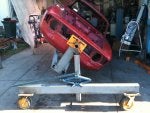As it turns out, all three of my 105s have varying levels of corrosion, and after much soul searching I've decided to put my priorities in order and dig into the family's egg-nest to save the old girls. College funds and retirement security are over-rated anyway.
I plan to start with the S2 spider, God willing, which already had a botched-up outer sills job (the man-child who worked on it in 2015 welded the drains shut to make sure that rust has the upper hand) and needed accident repair anyway. Spiders haven't really jumped up in value (yet) and I have found a burned S3 car with pristine floors which can be a stand-by parts donor if necessary.
Body guy and paint guy are both Syrians. Both are master craftsmen but the first is from the south (Damascus) and the other from the north (Aleppo), with very different approach to repair.
Damascus (before the stupid civil war) was a cosmopolitan city with global exposure to world markets and newer products, spares, technologies, etc... So on metal repair the craftsmen tended to be liberal with panel beating and metal shaping and cutting and welding on the premise that replacements (parts and panels or complete cars) are abundantly available.
Aleppo on the other hand was the major industrial productian hub but remained relatively isolated from global markets and the mind-set of its craftsmen was focused on preservation. Scarcity of resources translated to a more "gentle" approach to panel beating in favor of heavy use of primers and plasters to save the metal.
Pretty sure the two will get on each other's nerves, but hoping that'll be in the spider's advantage.
The shop is, well, a dump... But so far I managed (I hope [emoji848]) to convince them both to fashion a rotisserie rig and tie the car down tight before starting to cut into the underbody. I have also declared my deep phobia about broken glass (volvo... long story...) and sandblasting (no soda blasting in Jordan[emoji19]), so praying to be able to depend on dremel tools and wire brushes with the windscreen on and lots of POR15 along the edges (unless you guys convince me otherwise).
I may address some mechanical issues with the car stripped (clutch/gear bearings, engine & driveshaft mounts, etc...) but the big fear is of course the rubber and plastics once we start the strip-down in our land of scarcity and ridiculous customs duties and long shipping/clearing leadtimes... We'll see [emoji16]
![]()
![]()
![]()
![]()
Sent from my F8332 using Tapatalk
![]()
![]()
![]()





























